Tracing the lineage of tooling is just one pastime of any serious collector or hobby historian. Following the path of a model mold’s use from its inception through sometimes countless different companies and revisions is up there with spotting production phases of diesel locomotives or looking at a map of North American railroads and tracing the family tree of fallen flags that make up our contemporary national network. All these subjects feed our desire to sort and discern things of interest to better understand and appreciate them and make up a big part of the hobby. I believe this pursuit is a major draw for our collective hobbies of prototype railroading and model railroading.
In this installment, we’ll follow the transition that took place between two great hobby names: Varney and Life-Like. We will also pick up the story of what followed Penn Line’s demise in the early 1960s and trace where some of its catalog of HO scale offerings went, as that name factors into both lines during these years.
Among HO pioneering manufacturers, I believe you’ll agree Penn Line has never been given its due. You can mention names like Athearn or Mantua-TYCO to anyone in the hobby and they immediately know the company and its products, but Penn Line doesn’t seem to have the same recognition. I think Penn Line’s place in hobby history is challenged for many because the company was gone by the early 1960s. A contributing factor is the second, third, and even fourth careers some of Penn Line’s tooling enjoyed in the hobby. Some may be surprised to learn that some well-known HO scale models that have been on the market for years were first produced by Penn Line.

ABOVE: In early 1970, the pioneering Varney brand name passed into hobby history. These ads promote the recently introduced European-made HO-scale RS-11 model that briefly appeared under the Varney name but changed to Life-Like in advertisements appearing in the March 1970 issue of RMC.
A sidebar to understanding Penn Line’s catalog was the company’s inclusion of models (or components of releases) produced by other companies; decades later, this situation can cloud judgment and challenge identification of a sample in the wild without any packaging to aid in clarifying what you have before you. Several years ago, I received a call from a person working on Penn Line’s history. The gentleman investigating the company had questions about Athearn-produced F-unit and Geep shells and Mantua-made freight cars sold in Penn Line’s catalog. After discussing these Penn Line releases, I learned this person was more than an interested hobby enthusiast or collector. He was Garrett Stauffer, the son of Linwood Stauffer, one of Penn Line’s founders. The results of his research have recently been published by White River Productions as The Penn Line Story: A History and Collector’s Guide.
Penn Line supported its initial efforts jumping into the booming HO market of starter train sets in the mid-1950s by supplying its own mechanism and chassis under Athearn’s F7 and GP9 diesel locomotive shells. The company also filled out train set consists with the aid of Mantua-produced freight car models. Perhaps one of the most interesting sourced items for Penn Line was its inclusion of Fleischmann’s metal passenger car models dressed in Northern Pacific colors for a train set (there are also some mid-1950s sets with metal Fleischmann-made freight cars). This was not an uncommon approach, and you’ll find this practice served many others. The most famous example may be Lionel’s entry into the HO market in the late 1950s with products built for them by Rivarossi and Athearn, and later Lionel’s purchase of items from John English’s Hobbyline catalog…




